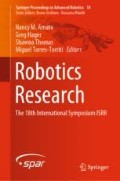Abstract
Efforts towards robust visual scene understanding tend to rely heavily on manual annotations. When human labels are required, collecting a dataset large enough to train a successful robot vision system is almost certain to be prohibitively expensive. However, we argue that a robot with a vision sensor can learn powerful visual representations in a self-directed manner by relying on fundamental physical priors and bootstrapping techniques. For example, it has been shown that basic visual tracking systems can be used to automatically label short-range correspondences in video that allow one to train a system with capabilities analogous to object permanence in humans. An object permanence system can in turn be used to automatically label long-range correspondences, allowing one to train a system able to compare and contrast objects and scenes. In the end, the agent will develop a representation that encodes persistent material properties, state, lighting, etc. of various parts of a visual scene. Starting with a strong visual representation, the agent can then learn to solve traditional vision tasks such as class and/or instance recognition using only a sparse set of labels that can be found on the Internet or solicited at little cost from humans. More importantly, such a representation would also enable truly robust solutions to challenges in robotics such as global localization, loop closure detection, and object pose estimation.
Access this chapter
Tax calculation will be finalised at checkout
Purchases are for personal use only
Notes
- 1.
This is true at least in the case of publicly available datasets.
- 2.
Solving a specific task, such as estimating the semantic class of a particular pixel, might then involve a further processing step which takes the full feature vector as input and produces only the relevant information, which might be as simple as projection onto a lower-dimensional vector which preserves the relevant information and discards everything else. If it is possible that this further processing step for all tasks can indeed be implemented as a projection, and furthermore that the projections are orthogonal and axis-aligned, then we can achieve the same effect by computing only the relevant part of the feature vector to begin with and avoiding the expense of computing feature dimensions that fall in the null space of the projection.
References
Agrawal, P., Carreira, J., Malik, J.: Learning to see by moving. In: Proceedings of the IEEE International Conference on Computer Vision, pp. 37–45 (2015)
Godard, C., Mac Aodha, O., Brostow, G.J.: Unsupervised monocular depth estimation with left-right consistency (2016). arXiv preprint arXiv:1609.03677
Levine, S., Finn, C., Darrell, T., Abbeel, P.: End-to-end training of deep visuomotor policies. J. Mach. Learn. Res. 17(39), 1–40 (2016)
Mnih, V., Kavukcuoglu, K., Silver, D., Graves, A., Antonoglou, I., Wierstra, D., Riedmiller, M.: Playing atari with deep reinforcement learning (2013). arXiv preprint arXiv:1312.5602
Schmidt, T., Newcombe, R., Fox, D.: Self-supervised visual descriptor learning for dense correspondence. IEEE Robot. Autom. Lett. 2(2), 420–427 (2017)
Wang, X., Gupta, A.: Unsupervised learning of visual representations using videos. In Proceedings of the IEEE International Conference on Computer Vision, pp. 2794–2802 (2015)
Zeng, A., Song, S., Nießner, M., Fisher, M., Xiao, J.: 3D match: learning the matching of local 3D geometry in range scans (2016). arXiv preprint arXiv:1603.08182
Author information
Authors and Affiliations
Corresponding author
Editor information
Editors and Affiliations
Rights and permissions
Copyright information
© 2020 Springer Nature Switzerland AG
About this paper
Cite this paper
Schmidt, T., Fox, D. (2020). Self-directed Lifelong Learning for Robot Vision. In: Amato, N., Hager, G., Thomas, S., Torres-Torriti, M. (eds) Robotics Research. Springer Proceedings in Advanced Robotics, vol 10. Springer, Cham. https://doi.org/10.1007/978-3-030-28619-4_14
Download citation
DOI: https://doi.org/10.1007/978-3-030-28619-4_14
Published:
Publisher Name: Springer, Cham
Print ISBN: 978-3-030-28618-7
Online ISBN: 978-3-030-28619-4
eBook Packages: Intelligent Technologies and RoboticsIntelligent Technologies and Robotics (R0)

